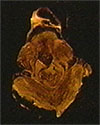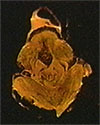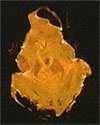
The
MRI's below show a wood frog thawing. The dark areas are frozen;
the light areas have thawed. Notice that it thaws out evenly.
This is important, because if it thawed from the outside in,
the limbs would thaw before the heart, liver, and brain, causing
the limbs to die.
|



MRI's
courtesy Dr. Boris Rubinsky.
|
|

Based upon his studies
of the wood frog, Rubinsky has designed a pilot protocol for freezing
donor organs (for the time being, rat livers) for long-term storage
prior to transplantation into a recipient. His protocol uses a
computer-controlled pump designed to mimic the wood frog's practice
of saturating its body with glucose. After the liver is removed
from the donor rat, the pump infuses the liver with a cryoprotectant
cocktail. The temperature of this cocktail decreases by two degrees
per minute, until freezing occurs.
One of the greatest
challenges in making the process work is delivering sufficient
quantities of cocktail to as many cells in the liver as possible.
According to Rubinsky, this consideration caused him to experiment
first with the liver. The liver, he says, is extremely well perfused
with an extensive network of blood vessels, helping to ensure
that his cocktail is well distributed throughout the entire organ.
Once Rubinsky has perfected
this process for the liver, he believes that it can also be adapted
to other organs, such as the heart and lung. Indeed, Rubinsky
and Storey are already conducting microscopic studies of freezing
in the hearts of wood frogs and rats.
So far, Rubinsky has succeeded
in reviving rat livers after six hours of freezing at -3°C.
During the process, 30 percent of the water contained in the livers
accumulates as ice. While the tissues of cryopreserved livers appear
intact even under a microscope, Rubinsky has further verified his
success by measuring the ability of revived livers to secrete bile.
"Bile production is a very good indicator of organ survival," he
says, "You need lots of biochemical processes to go right for it
to work."
But for a man who wishes
to revolutionize organ transplantation, the true test of this
new technology will be to demonstrate that livers which have been
cryopreserved can function after being grafted into recipients.
According to Rubinsky, such experiments are now underway with
rats as donors and recipients. Ironically, he says, finding a
transplant surgeon who is able to operate on such small patients
has been one of his greatest challenges. If these experiments
succeed, however, he won't have to worry about size much longer,
as he plans to request permission from the FDA to begin human
trials.
[end]
|